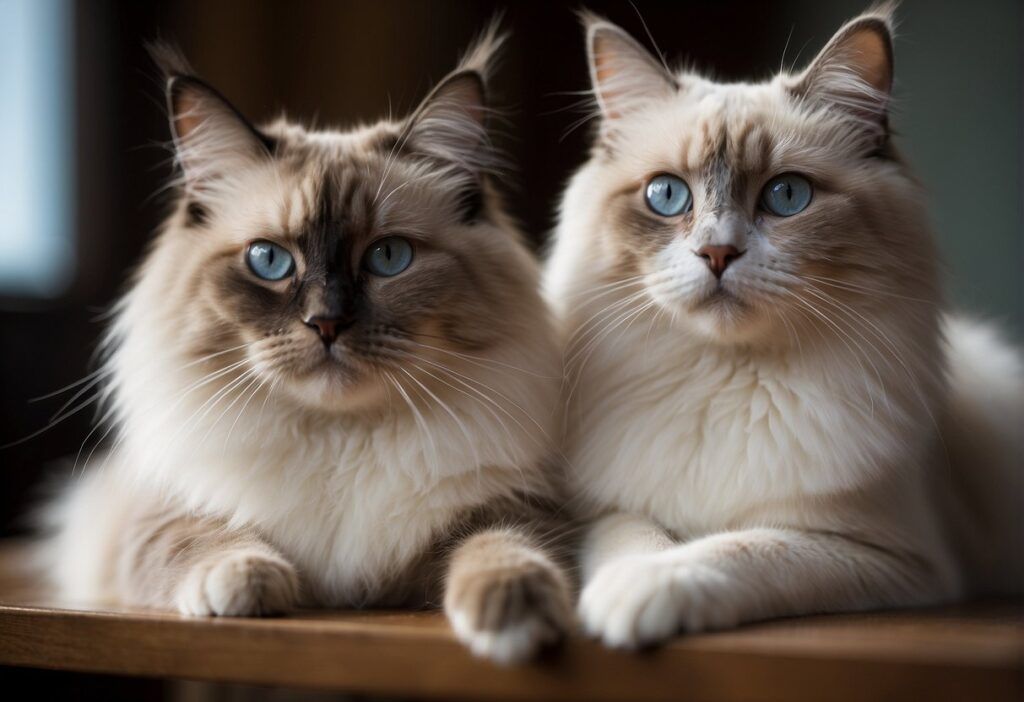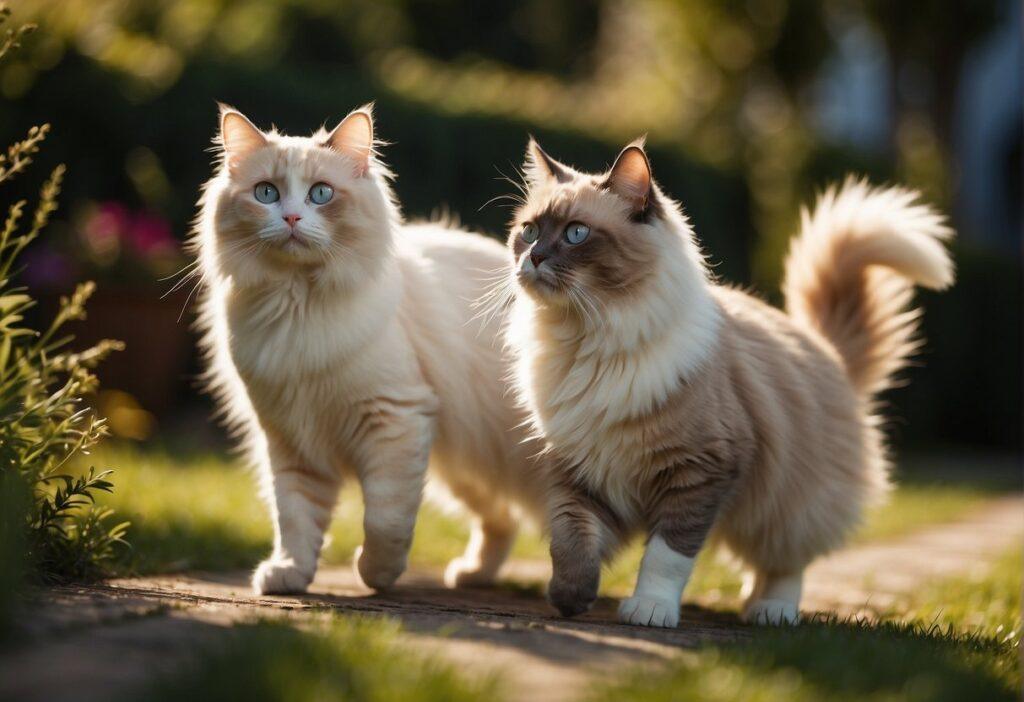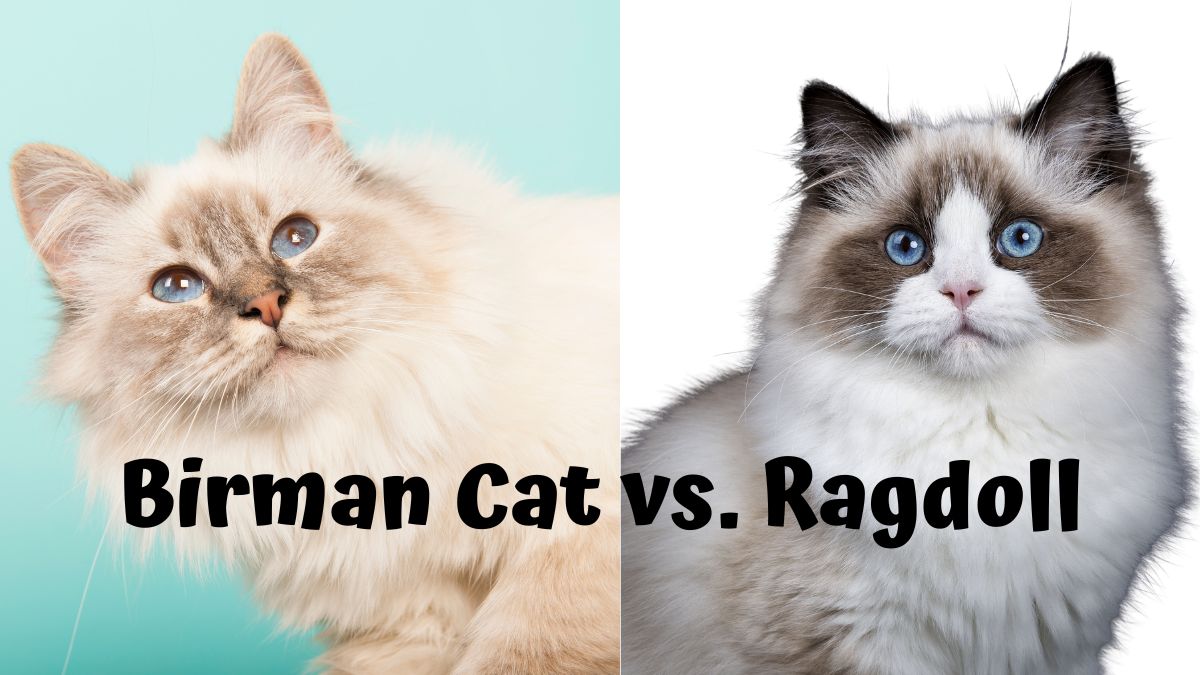Are you trying to decide between adopting a Birman or Ragdoll cat? If so, you have come to the right place. Both of these breeds are beautiful and mysterious creatures.
Birmans have this mysterious vibe—legend has it they came from Burma, and they’ve got these fantastic blue eyes and a super friendly attitude.
Then there are Ragdolls, which started turning heads in the ’60s over in California; they’re pretty laid-back and get big, too!
We will explore their histories, looks, and how they act to help anyone looking to adopt figure out which of these fluffy buddies would fit into their life better.
Both are total sweethearts, but they have their quirks, health stuff to consider, and different grooming needs.
A Birman might be your jam if you’re into medium-sized, mystical cats. But if you’re leaning towards a big, cuddly furball, then a Ragdoll could be the one.
Birman Cat vs Ragdoll Overview

The Birman and Ragdoll are two affectionate cat breeds with distinctive characteristics and rich histories, offering ideal companionship for families and individuals alike.
Historical Background
The Birman Cat has origins shrouded in legend but is believed to have been the treasured companion of temple priests in Burma, gaining the moniker “Sacred Cat of Burma.”
These cats made their way to France other parts of Europe, and the United States. In contrast, the Ragdoll breed was developed in the 1960s by Ann Baker in California.
They are said to descend from a white Persian or Angora-type cat and other breeds such as the Birman or Siamese.
Physical Characteristics
Birman cats are medium to large, featuring blue eyes, a silky coat, and contrasting color points reminiscent of Siamese cats.
Ragdolls are known for their large size, typically heftier than Birmans, with a distinctive semi-long coat, bright blue eyes, and a tendency to go limp when picked up, much like a rag doll.
Both breeds have striking beauty with soft, plush fur and pointed patterns.
- Birman Cats:
- Medium to large size
- Blue eyes
- Silky coat with color points
- Ragdoll Cats:
- Larger size on average
- Semi-long, soft coat
- Characteristic blue eyes
- Tendency to relax and go limp when held
Temperament
The Birman and Ragdoll are known for their affectionate and friendly nature, often sought after by those desiring an attentive indoor companion.
Birmans are sociable and gentle and enjoy the company of their human counterparts. Ragdolls share a similar temperament; they are laid-back, sweet-natured, and integrate well into family settings.
These cats are not typically aggressive and thrive in a nurturing home environment where they can be close to their owners.
- Birman Cats:
- Sociable and gentle
- Strong bond with family
- Ragdoll Cats:
- Laid-back and affectionate
- Enjoy being handled and are amiable with family members
Distinctive Physical Traits

Birman and Ragdoll cats are celebrated for their captivating looks, characterized by their luxurious coats and striking eye color.
However, their physical traits show considerable variety, specifically in their fur’s texture and patterns, body size and shape, and facial features.
Coat Differences
Birman cats boast a medium-length coat that is notably silky to the touch, allowing for a graceful flow that matches their dignified aura.
Patterns on their coat are distinct, with color seen on the ears, face, and tail, and they frequently have contrasting white “gloves” on their paws.
Ragdolls are known for their semi-long coats, which have a soft and plush texture perfect for snuggling.
These cats usually have colorpoint patterns similar to the Birman but can also display bicolor and mitted varieties featuring white chins and paws.
Body Size and Structure
When it comes to body size, Birmans are classified as medium-sized cats that carry a sturdy body and round contours.
They present a good balance between delicate elegance and robust physique. In contrast, Ragdolls are large-sized cats, typically heavier and more substantial in their bone structure.
One of Ragdoll’s defining traits is their tendency to go limp when held, contributing to their “ragdoll” moniker alongside their size.
Notable Facial Features
Birman cats possess expressive, deep blue eyes that draw attention to their symmetrical faces and contribute to their charming appearance.
Their rounded facial features, with a distinct Roman nose, give them a striking profile.
On the other hand, Ragdoll cats also exhibit beautiful blue eyes, but their faces tend to have a softer, more delicate appearance characterized by a gentle dip in the nose.
Behavioral Traits

Birman cats and Ragdolls are known for their friendly and calm demeanors, making them great companions for families or single pet owners.
When comparing these breeds, it’s essential to consider their social behaviors, level of affection, adaptability, and trainability.
Social Behaviors and Affection
Birman cats are sociable and enjoy human company. They often follow their owners around the house and crave attention.
They exhibit a gentle and patient nature, making them excellent companions, especially those who desire an interactive lap cat.
The Birman’s affectionate behavior is consistent, and they form strong bonds with their family members.
Ragdolls are also known for their affectionate and docile nature.
Their name derives from their tendency to go limp when picked up, similar to a rag doll, demonstrating their trust and relaxed demeanor towards their owners.
Ragdolls thrive in environments where they can receive plenty of affection and are also recognized as laid-back cats that can be ideal lap cats when they seek the warmth and comfort of their human companions.
- Birman Cats:
- Sociable with humans and other pets
- Seek out and enjoy human attention
- Ragdolls:
- They are known for their relaxed, floppy behavior when handled.
- Highly affectionate and enjoy physical closeness with owners
Adaptability and Trainability
Birman cats and Ragdolls showcase intelligence, facilitating their adaptability to new environments and situations.
These intelligent cats can learn tricks, respond to their names, and are generally easy to train due to their eager-to-please attitudes.
Birman cats adjust well to new surroundings and are pretty accommodating to changes in their routine.
Their energy level is moderate; they are neither overly active nor too indolent, striking a balance that suits various household dynamics.
Ragdolls are similarly adaptable, but their laid-back personality makes them particularly well suited for indoor living, where they can safely roam and play.
Their trainability can often lead to successfully introducing activities such as fetch and scratching posts, and they typically respond well to positive reinforcement training methods.
- Birman Cats:
- Intelligent and capable of learning tricks and commands
- Moderately energetic, quickly adjusting to new environments.
- Ragdolls:
- Display intelligence and laid-back energy levels, ideal for indoor activities
- Respond well to training with positive reinforcement techniques
Health and Lifespan

Birman and Ragdoll cats are beloved for their striking appearances and friendly dispositions.
However, potential owners should know the health issues and lifespan considerations specific to these breeds.
Common Health Issues
Birman and Ragdoll cats may experience typical feline health problems such as gum and kidney disease.
These issues often stem from genetic factors and can be influenced by environmental conditions and the owner’s standard of care.
Owners must maintain regular veterinary check-ups and provide proper dental hygiene to manage these health risks.
- Gum Disease: Regular dental checkups and cleanings can prevent the development of periodontal conditions.
- Kidney Disease: This can be managed with proper diet and regular veterinary care.
Breed-Specific Conditions
Birman and Ragdoll cats can also have genetic predispositions to certain breed-specific conditions.
Most notably, both breeds may be at risk for a form of heart disease known as hypertrophic cardiomyopathy (HCM).
A thickening of the heart muscle characterizes this condition and can potentially lead to heart failure if not correctly diagnosed and treated.
Birman Cats:
- Hypertrophic Cardiomyopathy: Screening and genetic testing by good breeders can help identify the risk.
Ragdoll Cats:
- Hypertrophic Cardiomyopathy: Regular heart health evaluations are crucial for early detection and management.
Owners who acquire Birman or Ragdoll cats from good breeders who perform proper health screenings may have a lower risk of encountering these conditions.
It remains essential for all cat owners to be proactive in monitoring their pets’ health and seeking veterinary care when needed.
Care and Grooming

Proper care and grooming are essential for maintaining the health and well-being of both Birman and Ragdoll cats.
Grooming Needs
Birman: The Birman’s coat is long and luxurious and requires regular attention to prevent mats and tangles.
A weekly brushing with a stainless steel comb is recommended to maintain its softness and manage shedding. These cats are known for their relatively average shedding.
Ragdoll: Similarly, Ragdoll cats sport a semi-long, silky coat that benefits from weekly brushing.
While Ragdolls share an average shedding trait with the Birman, they are less prone to matting due to their coat’s texture.
Both breeds may need occasional professional grooming sessions to address any fur issues that regular home grooming can’t resolve.
Diet and Nutrition
Birman and Ragdoll: A balanced diet is crucial for these breeds to stay healthy.
Birmans and Ragdolls typically thrive on high-quality commercial cat food for indoor cats. Portions should be appropriate for their age, size, and activity level to prevent obesity.
| Specific Needs | Birman | Ragdoll |
|---|---|---|
| Protein | High-quality animal protein | High-quality animal protein |
| Fats | Moderate amount of fats | Moderate amount of fats |
| Carbohydrates | Low | Low |
| Frequency of Meals | Two to three times daily | Two to three times daily |
Both breeds should always have access to fresh water, and treats should be given sparingly. Special attention to diet benefits allergy sufferers, as high-quality ingredients can minimize allergic reactions.
Related: Birman Cat vs Siamese: Exploring the Unique Traits and Nuances
Choosing the Right Cat for You
Selecting a Birman cat or a Ragdoll entails understanding their distinct traits and how they fit into your lifestyle.
Considerations for Families
When introducing a child-friendly breed like Birmans or Ragdolls into a household with young children, it’s important to acknowledge that each cat has its personality.
Birmans tend to be sociable and enjoy spending time with family members, while Ragdolls are known for their gentle temperament, often making them an excellent choice for families.
Both breeds exhibit low vocalization, keeping the home environment relatively quiet.
Cost and Breeder Information
Reputable breeders may charge a premium for these beautiful cats, but a healthy and well-socialized pet is worth the additional cost. Here is some specific information to consider:
- Rescue Cat: Often less expensive, adopting a rescue Birman or Ragdoll can be a way to provide a home to a cat in need.
- Allergic Reaction: If allergies are a concern, meet the cat before adopting to check for potential reactions.
- Male Ragdolls: These can be larger than females, potentially leading to higher costs for food and care.
- Show Breeder vs. Reputable Breeder: A show breeder may offer pedigree cats that can be shown at events, often at a higher price. Reputable breeders focus on the health and temperament of the cats.
- International Cat Association: Check if the breeder is registered with organizations like the International Cat Association for peace of mind.
Making an informed decision involves understanding the responsibilities and costs associated with cat ownership.
Introducing Cory Haasnoot, a devoted father, loving husband, and enthusiastic cat lover. As a key content creator for CatFurLife.com, Cory blends his family values and passion for felines into engaging and informative content. He brings a unique perspective to the site, sharing cat care tips and how cats can enrich family life and bring joy to households.

